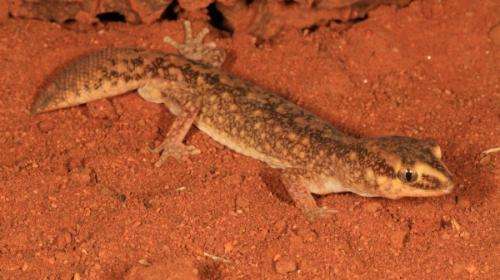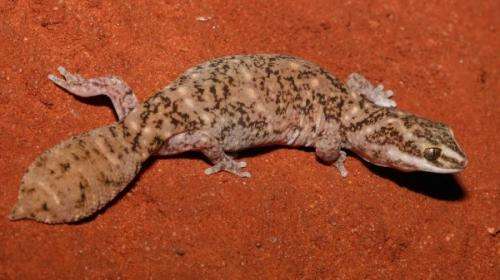Resilient geckos crop up in the northwest of Australia

Research into a type of Fat-tailed gecko (Diplodactylus conspicillatus) in northern Australia has revealed it is not one species but seven.
The discovery brings three new species to the Western Australian gecko record, and another three in the Northern Territory and Queensland.
It brings the number of Fat-tailed geckos in WA to four—one in the Kimberley, one in the Pilbara and two with wide and overlapping distributions across WA's arid zone.
The gecko's high genetic diversity suggests it may need to be split into still more species.
The Australian National University scientists examined gecko specimens held in museum collections across Australia, including from the Western Australian Museum, and conducted genetic and morphological tests on the specimens.
They placed some geckos into major lineages based on their physical characteristics including enlarged plate-like scales on the nape, an enlarged upper jaw and an original tail with a pointed tip.
The research transforms understanding of a group that was regarded as among the most widespread of the Australian lizards.
It reveals divergent species with contrasting distributions and histories, with some lineages adapting to aridity while others appear to have retreated into shrinking mesic refugia across northern Australia.

ANU post doctoral research fellow Paul Oliver says ongoing research using ever-improving genetic testing techniques is revealing that many supposed 'species' actually comprise deeply divergent groups.
He says in many cases these divergences warrant them being split into different species, thus adding to the country's biodiversity record.
"As my old supervisor used to put it, we are 'pulling their genes down' to reveal the true diversity of Australian lizards," Dr Oliver says.
The gecko study is part of a broader research program to understand how aridification has shaped the evolution of Australia's animals.

Lizards and snakes, as arguably the most successful vertebrate group in Australia, are playing a key role in shaping this understanding.
"Systematic work over the last two decades has revealed numerous instances where overly conservative taxonomy has obscured interesting patterns such as long-term persistence, micro-endemism, inter-regional dispersal events and morphological stasis," Dr Oliver says.
He says discovering new species is also important for conservation, as it highlights areas of endemism, which can in turn inform decisions about conservation reserves and land management.
"It's really interesting and important work as we are going to be able to point to areas across the landscape that we didn't even realise were important," Dr Oliver says.
More information: "Independent Transitions between Monsoonal and Arid Biomes Revealed by Systematic Revison of a Complex of Australian Geckos (Diplodactylus; Diplodactylidae)."
Provided by Science Network WA





















